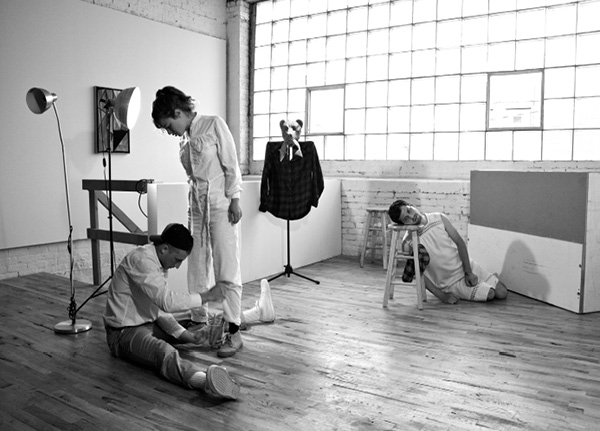
THE HIDDEN WOODS IN THE CONVERSATION
first performed May 14, 2012
Alderman Exhibitions, Chicago, IL
performed three times in 2012
HUSBAND / ANNIE MAURER, MILLIE KAPP, MATTHEW SHALZI & NOAH FURMAN
New York, NY
THE HIDDEN WOODS IN THE CONVERSATION
HUSBAND / ANNIE MAURER, MILLIE KAPP, MATTHEW SHALZI & NOAH FURMAN
The “Hidden Woods in the Conversation” is a performance grounded in a text entitled “On the Marionette Theater,” by Heinrich Von Kleist. In making the performance, the text operated in two ways: as a collection of ideas to decipher and critique through discussion, and as a poetic inspiration for choreography. Von Kleist praises the marionette—the machine—as a more graceful dancer than the self-conscious human. In response, we used directives and scores to chart the movement of our own self-consciousness as we performed for one another. Some of the these directives included the following questions:
How can we locate and qualify the kinds of self-consciousness elicited by specific tasks? What is the distinction between holding a carrot between your buttocks in front of an audience, in rehearsal, and in private? How can experiments in self-consciousness challenge notions of grace in dance and the politics of being seen?
The directives are literal instructions and material to play with and re-interpret. The invitation to re-interpret undermines language as a device for control as well as any directorial presence. The fluid relationship between instruction and embodied response challenges the traditional hierarchy implicit in teacher and student, director and ensemble, mind and body. The author of the work is comprised of a community, a piling of multiple voices and ways of understanding that produce a singular entity: the performance.
In our responses to prompts and scores from “On the Marionette Theater,” we observed various points of focus and degrees of internal/external awareness. This material was arranged to produce a performance between dance and task, logic and nonsense. In light of Von Kleist’s ideas on dance, “the Hidden Woods in the Conversation” may be understood as a proposition to consider how the precise composition of language, objects, and bodies might produce a constellation of varying, layered consciousness.